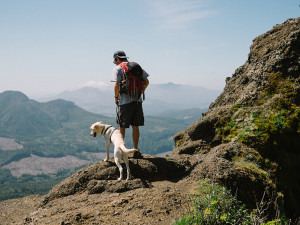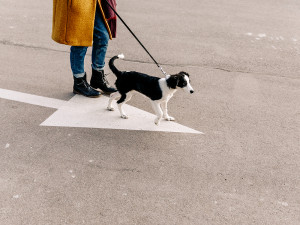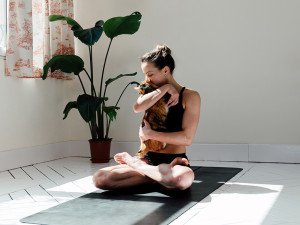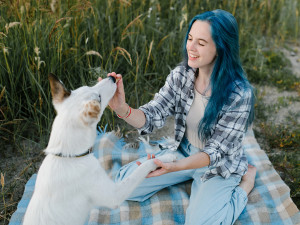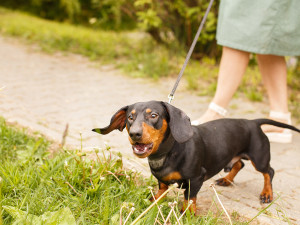Walking the Dog Doesn’t Have to Be a Chore—What to Try Instead
Here are some other ways you can get some quality time and exercise with your pup.
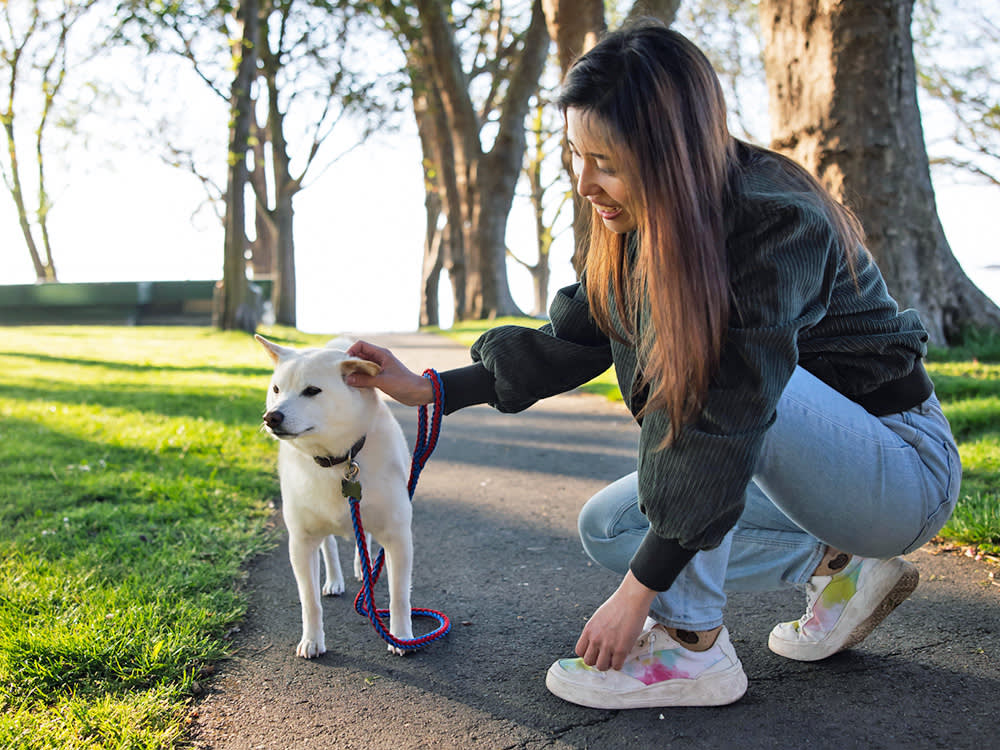
Share Article
Toward the end of Cal Newport’s 2016 self-help book opens in new tab Deep Work: Rules for Focused Success in a Distracted World, he labels walking the dog as potentially “wasted” time. And he isn’t the only one who feels that way. My partner recently listened to a podcast suggesting we might outsource dog walks to robots in the future, along with washing dishes and folding laundry. When we dog-sit for friends, “daily walk” always appears on the agenda as something that needs to get done.
But a neighborhood stroll isn’t the only way to fulfill our pets’ exercise needs. And when walks become obligations to cross off our never-ending to do lists — instead of opportunities to revel in our human-canine bond — both ends of the leash suffer.
Here’s an exploration of why so many of us (I include myself in this) sometimes feel like walking the dog is more of a chore than something we enjoy. Plus, experts offer ways to make walks more fun (and enrichment alternatives that can spice things up).
What makes walking the dog feel like a chore?
“I have so many clients say to me, guiltily, that they haven’t walked the dog in days or weeks. They feel awful about it,” says Molly Fisher, canine behaviorist and founder of the Raising My Rescue opens in new tab online program.

Jess Adamopens in new tab, a licensed therapist and dog-parent coach in Philadelphia, says “our beliefs about a dogs’ role in our lives influence our feelings about dog parenthood and all that comes with it, including taking our dogs for a walk. If I look at a dog walk as something I ‘have’ to do, something that just serves my dog without giving anything to me in return, I’m more likely to feel frustrated or unmotivated. The walk will be a chore.”
In today’s society, walking the dog has become exactly that: something we have to do.
We see daily walks as a pet-parenthood duty.
Countless books, movies, and TV shows present walking the dog as the epitome of pet parenthood. In films like Monster in Law (2005), the protagonists meet because one of them is on a dog walk. Lessons in Chemistry, Bonnie Garmus’s 2022 debut novel, uses the family dog’s leashed walk as a major plot point. (I can’t say more without spoilers.) We’re surrounded by images of fellow pup parents hitting the streets with their companions.
When we internalize this norm — applying the sweeping generalization that “to be a good dog guardian, we must go on daily walks” — the pressure is unproductive.
Modern society pushes us to optimize everything, even our relationships.
Couple that “walking the dog is peak pet parenthood” belief with our society’s go-go-go energy, and the stakes feel higher. We’re obsessed with productivity in the digital age. How do we get more done — and how do we complete it in less time? While this thought process might work for life-hack bros, it does our pets a disservice if we start viewing dog parenthood as another role to hack, optimize, and cross off our lists. After all, they aren’t laundry or dishes; they are our family.
Of course, we want to live in a world where our input results in the desired output. It’s easy to believe if we put the right things in (like detergent for our dishwashers, daily walks for our dogs) we’ll get what we want as an outcome (clean coffee mugs, unconditional love). Life isn’t that simple, though, and caring for a dog definitely isn’t. No loving relationship can be distilled to a checklist — even if we sometimes crave that simplicity.
Pet parenthood is an ongoing journey with another sentient being. There’s no magic formula to create harmony with our companions. (I know this after years of trying, to no avail, to find one.) So, if checklists help you stay on top of a million moving parts, embrace them.
But don’t reduce your relationship with your dog to a few items on your agenda. Yes, walks are a necessity, especially if you don’t have a fenced-in yard, and going out on a leash is the only way your pup gets their pee break. But there are ways to reframe the task so that we can enjoy it, too.
The benefits of spending engaged time with our dogs
“If we can find things we enjoy doing with our dogs and create intentional time for those activities, we’re going to feel much more connected and fulfilled in that relationship,” Adam says.
Both we and our pets reap the benefits of true social connection. Spending time with your pup can boost oxytocin. Domestic dogs might even prefer interacting with humansopens in new tab over hanging out with members of their own species — a trait that sets them apart from every other animal we’ve studied. When we bring an animal into our homes, we have a responsibility to see them as more than another obligation. Our pets are our friends.
Tweaking our dog-walking schedule to prioritize the activities we love best can be a great way to increase everyone’s enjoyment. So, for example: Maybe you want to get some cuddles in before you go on that lengthy walk. Do something you both enjoy first before you head out on the long trek. (Of course, make sure your doggo gets their potty needs met on time.)
“Having a healthy, balanced, sustainable relationship with our pets is truly like any of our human relationships,” Adam adds. “In order to avoid disconnection developing over time, we require reciprocity and give-and-take.”
How do you know it’s time to walk less and add different activities to your routine?
Your dog struggles on walks.
In the early days with my Australian Cattle Dog, Scout, I felt I hadn’t completed my work for the day until we’d gone on a neighborhood walk. The problem was that neither of us really enjoyed these excursions.
Scout came to me timid around other dogs — and each time we stepped outside our apartment, we were sure to encounter scary triggers. At best, defining our success based on blocks traveled discouraged me. At worst, it harmed our relationship and slowed her training when I put her in situations she wasn’t ready for. “Walks that are stressful, full of triggers and exhausting, are not positive,” Fisher confirms.
You feel bored on your daily walks.
We — and our dogs — crave novelty. We learn best “in environments where there is a lot to learn,” write researchers Angeline S. Lillard and Alev Erisiropens in new tab. Exploring new smells, sights, and situations engages your pup’s brain.
It’s normal to get bored on the same route every day. Habits can be helpful, but not if we’re stuck mindlessly walking at the same time, in the same place.
You aren’t motivated to get out on walks.
Strict walking regimens can make dog parenthood harder, not easier, when we struggle under their weight. Adam notes “if we feel pressured to do things we don’t truly enjoy for the sake of our pet, we’re more likely to feel burdened by those activities, rather than excited to engage in them. That won’t be helpful for anyone’s emotional state over time.”
Enrichment alternatives to the traditional daily walk
“While giving your dog adequate exercise and enrichment is incredibly important, I find clients sigh with relief when I explain about the alternative ways to enrich their dogs’ lives,” Fisher says. Mental and physical stimulation take many formsopens in new tab.
If walking your dog long distances doesn’t bring joy to both ends of the leash, here’s what to try instead.
Interactive play (at home or on the go)
One thing that sets domestic dogs apart from many other animals: They play all the way into adulthoodopens in new tab. (Humans do, too.) Through games, you can improve your pet’s brain healthopens in new tab and strengthen your bond.
Tug-of-war: Along with satisfying some of your dog’s natural instincts, tug is a great opportunity to work on their impulse control and cooperation.
Fetch: Chasing fast-moving objects is hardwired into our pets. A game of fetch (with warm-up and cool-down periods to prevent muscle injury) can provide great physical exercise.
Hide-and-seek: Feeling something slower? Hide-and-seek lights up your dog’s desire to search their environment and satisfies their social drives. Have your dog wait in another room while you hide just out of sight, then call them to find you.
Passive socialization
Many modern pets spend the bulk of their lives inside our homes. That’s not ideal for intelligent, curious animals. (Did you know domestic dogs are so smart they can learn new things just by watchingopens in new tab humans?) Exposure to novel stimuli can prevent your pup from getting bored — but you don’t necessarily have to walk in your neighborhood to do it.
Bring your dog to a pet-friendly coffee shop or restaurant patio.
Drive to a new park to watch the world go by.
Visit a pet-friendly store or outdoor mall.
DIY nosework
The best part of a walk for most dogs is the smells. You can get some of the same sniffing benefits with simple nosework games.
Tell your dog to stay or have someone else hold them out of sight.
Hide treats or parts of their meal around a familiar room (to increase the difficulty, you can progress to searches in more distracting environments).
Release your pup to sniff out their rewards.
Trick-training
Tricks are a great way to work your pup’s mind. Clicker training (also called reward marker training) is especially effective to teach complex behaviors. If you want to go big, consider pursuing an AKCopens in new tab or Do More With Your Dogopens in new tab trick training title. It’s easier than you think: You can submit your dog’s skills via video.
Obstacle courses
Build mental and physical toughness by helping your dog conquer an obstacle course. Use household objects, like chairs and couch cushions, to create an indoor challenge, or take advantage of natural features in your yard or favorite park.
Canine-conditioning exercises
Stretching and strengthening are important for any active animal. You can teach easy canine conditioning exercisesopens in new tab, like puppy push-ups, in a few training sessions.
Make things even more engaging by working out alongside your dog. Ask them to hold a sit stay while you hold a plank, or practice their loose-leash skills while you do walking lunges. Need more guidance? Peloton has even started offering pet-friendly fitness classes.
Get creative
Come up with fresh activities based on your own dog’s personality. The more new things we do with our pets, the closer we become.
How much walking is enough? Find what works for you.
Busy schedules benefit from set routines. Daily walks, especially with opportunities to sniffopens in new tab, can be a great habit to make sure your pup gets what they need.
But if walking your dog has become a chore — something you feel obligated to do even though you don’t want to — it’s time to explore enrichment alternatives. “Making lives a little easier and happier through other forms of enrichment is better than going on a daily walk if the dog and person aren’t enjoying it,” Fisher says.
Spend a few minutes contemplating what activities your pup loves most. My dog gets very little out of standard leashed walks in urban environments, but her heart sings when we play tug. (A bonus: The game pushes me to be more present than when we walk on a well-traveled sidewalk.)
If your dog really does enjoy long walks more than anything else? You should take them — at least sometimes. “Sometimes, a walk is a necessity,” Adam says. “In those moments, we can lean on our values and remember that although we might not necessarily feel motivated in the moment, the commitment we made to caring for our dog is important to us.”
If your pup struggles with behavioral issues like leash reactivity, a professional trainer can help you develop strategies to get through the neighborhood without barking explosions. If you’re bored taking the same route, try turning on different streets (or even driving a short distance to another part of town if you have the opportunity).
The rule of thumb: Provide your pup with sufficient physical exercise and mental stimulation to feel their best. But don’t get caught up walking a certain distance or set amount of time every single day. Switch it up. Your dog will thank you, and you won’t be including your strolls on your to-do list anymore. Guaranteed.
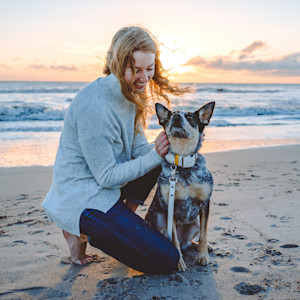
Haley Young
Haley Young is a freelance writer specializing in domestic dogs: their training, fulfillment, and relationships with the people who love them. She travels the country full-time in a converted camper van with her rescued Blue Heeler, Scout.
Related articles
![Person walking their dog in the street]()
How to Leash-Train a Puppy or Dog
Don’t let your new dog walk you.
![A woman holding a cat close to her while sitting on a yoga mat.]()
Shockingly, Your Pet Will Enhance Your Mindfulness Practice
The next time they try to kiss your face while you’re in corpse pose, let them.
![girl with blue hair starting puppy training with white dog]()
Puppy Training 101: How to Train a Puppy
You gotta start somewhere.
![A shy looking dog sitting on a couch.]()
Some Dogs Are Scaredy Cats — And That’s OK
Not all fearful dogs have been mistreated.
![A woman walking a dog on a leash and a dog barking at something.]()
Is Your Out-of-Control Dog Lunging on the Leash?
Even a mild-mannered dog can turn into a wild thing when feeling trapped.
How to Manage Leash Reactivity in Your Dog
If your pup acts diabolical on walks, you are not alone. Here’s what you can do.


